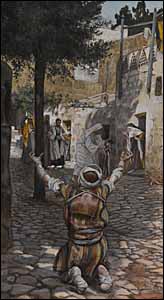Free E-Mail
Bible Studies
Beginning the Journey (for new Christians). en Español
Old Testament
Abraham
Jacob
Moses
Joshua
Gideon
David, Life of
Elijah
Psalms
Solomon
Songs of Ascent (Ps 120-135)
Isaiah
Advent/Messianic Scriptures
Daniel
Rebuild & Renew: Post-Exilic Books
Gospels
Christmas Incarnation
(Mt, Lk)
Sermon on the Mount
(Mt 5-7)
Mark
Luke's
Gospel
John's Gospel
7 Last Words of Christ
Parables
Jesus and the Kingdom
Resurrection
Apostle Peter
Acts
The Early Church
(Acts 1-12)
Apostle Paul
(Acts 12-28)
Paul's Epistles
Christ Powered Life (Rom 5-8)
1 Corinthians
2 Corinthians
Galatians
Ephesians
Vision for Church
(Eph)
Philippians
Colossians,
Philemon
1
& 2 Thessalonians
1 & 2 Timothy,
Titus
General Epistles
Hebrews
James
1 Peter
2 Peter, Jude
1, 2, and 3 John
Revelation
Revelation
Conquering Lamb of Revelation
Topical
Glorious Kingdom, The
Grace
Great Prayers
Holy Spirit, Disciple's Guide
Humility
Lamb of God
Listening for God's Voice
Lord's Supper
Names of God
Names of Jesus
Christian Art
About Us
Podcasts
Contact Us
Dr. Wilson's Books
Donations
Watercolors
Sitemap
11. The Will to Make Lepers Whole (Luke 5:12-16)
 James J. Tissot, 'Healing of the Lepers at Capernaum' (1886-94), gouache on gray wove paper, 11.25 x 6.2 in., Brooklyn Museum, New York. |
Have you ever been shunned or ostracized? Ever been excluded for your accent or skin color, gender or poverty, religion or politics, caste or family? If so, I want you to try to connect with that experience for a few minutes, to try to understand what it meant to be a leper in Jesus' day. Observe how Jesus treated this remarkable leper.
"12 While Jesus was in one of the towns, a man came along who was covered with leprosy. When he saw Jesus, he fell with his face to the ground and begged him, 'Lord, if you are willing, you can make me clean.' 13 Jesus reached out his hand and touched the man. 'I am willing,' he said. 'Be clean!' And immediately the leprosy left him. 14 Then Jesus ordered him, 'Don't tell anyone, but go, show yourself to the priest and offer the sacrifices that Moses commanded for your cleansing, as a testimony to them.' 15 Yet the news about him spread all the more, so that crowds of people came to hear him and to be healed of their sicknesses." (Luke 5:12-16, NIV)
Unclean
Leprosy in Biblical times was a terrible thing. We're not exactly sure what Biblical leprosy was. While it may have described what is known today as "Hansen's Disease," the word probably included other skin diseases, as well.105 Whatever it was, once a person caught it, it was considered incurable, and those diagnosed with leprosy were banned from society.
"The person with such an infectious disease must wear torn clothes, let his hair be unkempt, cover the lower part of his face and cry out, 'Unclean! Unclean!' As long as he has the infection, he remains unclean. He must live alone; he must live outside the camp" (Leviticus 13:45-46).
While early Israelites didn't operate on the Germ Theory of disease, they understood something about infectious diseases, and those suspected of leprosy were kept isolated until their diagnosis was confirmed (Leviticus 13:5). But the loathing directed at lepers was not merely fear of a disease. Leprosy made a person ritually unclean. To touch a leper defiled a Jew almost as much as touching a dead person. In a sense, leprosy was a sign of God's disfavor.
Later Jewish practice prescribed that while lepers might attend synagogue, they must be the first to enter and last to leave, and must stay in a special compartment to isolate them from the other worshippers.106 No less than a distance of four cubits (six feet) must be kept from a leper.107
To the rabbis, the cure of a leper was as difficult as raising a person from the dead.108 In all Biblical history only two people had been cured of leprosy -- Miriam, who had leprosy for seven days as a punishment for speaking against Moses' leadership (Numbers 12:9-15), and Naaman, general of the army of Aram, a heathen from Damascus (2 Kings 5). When he obeyed Elisha's instruction to wash seven times in the Jordan River he was healed. Healing a leper had not been done in Israel for seven hundred years, and was thought to be an earmark of the Messianic Age (Luke 7:22), when leprosy would no longer afflict people.109
A Leper Begs Jesus (Luke 5:12)
Jesus has left Capernaum and is on one of his preaching tours through the towns of Galilee. The incident we are studying takes place in one of these towns, almost "by accident." Jesus is going about his business, perhaps preaching or teaching outside, perhaps shopping at the open air market, we don't know. But a leper who happens to be nearby sees him.
The leper is far advanced with the disease. The parallel accounts in Matthew 8:1-4 and Mark 1:40-45 just refer to him as a leper, but Luke the Physician says he is "full of leprosy" (KJV, RSV), "covered with leprosy" (NIV).
Try to imagine the disfigured man, dressed in tattered clothing, his face partly covered, shadowing the edge of the village street so as to avoid people, seeing Jesus there. His stare fixes upon Jesus. Perhaps he has seen him teaching, perhaps he hears the whispers of those around him pointing and saying, "That's Jesus the Healer. I wonder what he'll do in our town?"
The man stands rooted there, trying to decide. No leper has been healed since Elisha's time, and yet Jesus has healed many incurable diseases; his reputation has spread far and wide. If he can cure other illnesses, why not leprosy?
But to come to Jesus for healing is a risk in itself. The leper will be beaten if he doesn't strictly observe the rules to keep his distance from "normal" people, at least six feet, and some people will throw dirt and stones at him if he is twice that distance.110 But he must risk it. If Jesus can heal him, he must risk any punishment, however severe. He must!
So now, all of a sudden, he rushes across the street to where Jesus is standing, and falls down with his face to the dust before him, as in the Muslim manner of prayer. You can almost hear a gasp from the people around Jesus, and they involuntarily take a step back, hands to their mouths.
Willingness to Heal (Luke 5:12b-13)
From his position of abject submission and obeisance, the leper begs, not even daring to look up, "Lord, if you are willing, you can make me clean."
When you think about it, his statement is remarkable for its faith. Here is a man who states his belief that Jesus can do what only Elisha could do -- heal a leper. It isn't a matter of ability, the leper is saying. It is a matter of will. Jesus is able to heal him, the man boldly states. Is he willing to?
The leper voices a question that many of us have today. We know theoretically that Jesus is able to heal -- after all, he is the Son of God. But our faith doesn't extend to the hardest situations: to cancer, to multiple sclerosis, to chronic heart failure. We hope rather than know. We hope and plead and bargain with God. But many times our hope doesn't quite rise to the rim of actual faith. Our Western mindset is much more willing to believe the impossibilities of medical science than the possibilities of divine intervention. And so we struggle.
But the leper goes a step further than the rest of us. Certainly, every witness on the village street that afternoon believed without a shadow of a doubt that God could heal leprosy. But very few believed that Jesus could or would. This was impossible; everybody knew that. Sure, Jesus had done some miracles, but heal leprosy? It wouldn't happen. Those people are unclean, disfavored by God.
But as soon as the leper has vocalized his plea, "Lord, if you want to, you can make me clean," the crowd is suddenly hushed. What will happen?
Jesus is standing. The leper is kneeling, face to the surface of the street, inches from Jesus' feet, doing violence to the four-cubit rule of distance.
And then Jesus begins to stoop. I can't help thinking that he must be smiling. Smiling in compassion, yes. But also smiling at the boldness of the man's faith. The Yiddish word to describe this is chutzpah, "nerve, gall ... conspicuous or flagrant boldness."111 Sometimes when we are desperate, we are able to vault our doubting inhibitions and reach out for what we need. Moses showed it on behalf of the people of Israel (Exodus 32-33), and God was pleased. Job displayed it in the face of his tormenting "friends," and God honored his faith. We see this kind of bold, stepping out, recklessness in Peter, and Jesus loves him for it.
Before the eyes of the onlookers, Jesus begins to stoop down and reach out his hand. He extends his arm until his fingers and the palm of his hand rest on the unclean leper's head. A murmur goes through the crowd as Jesus touches the unclean man, and then stills as Jesus speaks quietly: "I want to, be clean!"
Luke records, "Immediately the leprosy left him." A moment before, he was covered with leprous sores and lesions, "full of leprosy," and now his skin is clear, unblemished. A dramatic and instant transformation has taken place in him. I see him looking up now into Jesus' face, and Jesus' hand that was on his head has slipped down to the side of his once leprous face, touching ex-leper's black beard.
A gasp goes through the bystanders. The man is healed! The leper is healed! The Greek word used is katharizō, literally, "make clean, cleanse, purify."112 In an instant, the man is physically healed and spiritually cleansed. He is now whole!
A Strange Command (Luke 5:14b)
But Jesus continues to speak to the man and command him -- certainly a strange tone for such a heady moment as this. The Greek uses a strong word: parangellō, "give orders, command, instruct, direct."113 "Don't tell anyone," Jesus says, "but go, show yourself to the priest and offer the sacrifices that Moses commanded for your cleansing, as a testimony to them."
Jesus is sometimes accused of abrogating the Mosaic Law, but here he upholds it. Lepers who no longer display symptoms must be declared clean by the health inspector of the day, a priest. Moreover, there are specific sacrifices that must be offered (Leviticus 14). Then, and only then, may the leper be welcomed back into society.
But what does Jesus mean, "Show yourself to the priest and offer the sacrifices that Moses commanded for your cleansing, as a testimony to them." A testimony to whom? To the priests, or to the people? Perhaps to both. Those sacrifices could only be offered in Jerusalem. What a stir it must have made for an ex-leper to appear at the Temple at Jerusalem demanding a certificate of cleansing and offering sacrifices on the holy altar. Jesus' command sent two signals: both of Jesus' adherence to the Law, and probably an unintended indication to the religious authorities in Jerusalem that lepers are being healed, that the Messianic Age is upon us, that the Kingdom of God IS at hand!
A Command to Silence (Luke 5:14a)
But what are we to make of Jesus' "strong warning" (NIV, Mark 1:43) to the man not to tell anyone? We see this secrecy a number of times in Jesus' ministry, especially in the Gospel of Mark.114 In 1901, Wilhelm Wrede wrote The Messianic Secret to try to explain this phenomenon. Jesus silences the demons who know who he is, he warns the disciples not to tell openly that he is the Christ, and he commands the healed not to tell what happened. Why? Two reasons, I believe.
1. To prevent premature identification as the Messiah. Jesus' self-designation as "Son of Man" (taken from Daniel 7:13) is ambiguous enough to turn aside speculation. But the more Jesus is widely rumored to be the coming Messiah, he becomes a religious threat to established Judaism and a political threat to the Roman rulers. Jesus wants to avoid the term Messiah or Christ as long as possible so people will absorb his teaching, rather than fixate on his future plans.
To prevent being mobbed. Jesus reputation as a healer brings crowds. But when he becomes known as the Healer of lepers or one who raised people from the dead, he is absolutely mobbed and effectively loses his ability to enter a town easily, or spend time privately with his disciples. Mark records that the leper doesn't keep silent:
"Instead he went out and began to talk freely, spreading the news. As a result, Jesus could no longer enter a town openly but stayed outside in lonely places. Yet the people still came to him from everywhere" (Mark 1:45).
The Contrast of Crowds and Seclusion (Luke 5:15-16)
The final verse in our passage contrasts vividly Jesus' increasing popularity with his desire to be alone.
"The news about him spread all the more, so that crowds of people came to hear him and to be healed of their sicknesses. But Jesus often withdrew to lonely places and prayed." (Luke 5:15-16)
Jesus' fame spreads rapidly by word of mouth. Travelers pass the news of Jesus to the next village. The priests soon have a man claiming to be healed of leprosy, insisting to offer sacrifices that haven't been offered in the Temple in anyone's memory.
But in the midst of the public adulation and clamor, Jesus is unmoved. Instead, he withdraws often to be alone and pray. The Greek word pair translated "withdraw" uses the imperfect tense which suggests continued action or established habit. The Greek word hypochoreō means "go back, retreat, withdraw," also in a peaceful sense, "retire."115 The power of his word and healing are displayed in public, but the secret of his ministry is known only to his disciples, who see him creep off early into the hills to pray. It becomes a rhythm of his life: minister to the people and then withdraw to pray and talk to his Father. The disciples see his prayer life and remember. Gradually -- and especially after his ascension -- they learn to pray the same way. Jesus' rhythm needs to be our rhythm, too. Pray and do, pray and minister.
Lessons for Disciples
I see several lessons for disciples in this passage:
- Jesus' expressed will is to heal. That should be our assumption, not considered the exception (as it often is by those who take 2 Corinthians 12:7-9 as their chief healing text).
- Jesus doesn't shrink from touching the unlovely. Neither should we.
- Our faith should be as bold as the leper's in order to receive from Jesus.
- Jesus demonstrates our need to develop a regular pattern of private prayer.
 Lessons compiled in 805-page book in paperback, Kindle, & PDF. |
When you consider your own life's experience, which image speaks loudest to you? The leper who becomes bold enough to ask wholeness from Jesus? Or, the healer who is challenged to love and reach out to the unloved rather than avoid them? As Jesus' twelve disciples observed and wondered and internalized this astounding Life, so do we. So MUST we!
Prayer
Lord, sometimes I feel like the leper who rushed to Jesus and bowed low at his feet. "If you want to, Lord, you can make me whole." That is my prayer. I don't doubt your desire or your ability to make me whole. Now I ask that you would continue to work your wholeness in my entire life, body, soul, and spirit. Transform me. Touch me. Say to me, "I want to; be whole." Thank you, Lord. In Jesus' name, I pray. Amen.
Key Verse
"Lord, if you are willing, you can make me clean." Jesus reached out his hand and touched the man. "I am willing," he said. "Be clean!" (Luke 5:12-13)
Questions
Click on the link below to discuss on the forum one or more of the questions
that follow -- your choice.
https://www.joyfulheart.com/forums/topic/1926-11-leper/
- Who in our society are treated like lepers were treated in Jesus' day? Who sometimes feels like a leper in the presence of Jesus?
- Describe the kind of faith it takes to act and speak as this leper did. What level of belief was required of him?
- What is the difference between believing God can do something for us and believing that he wants to do something for us? Would you call the difference faith? or knowledge? or both?
- "I will. Be clean!" is pretty strong. Can you think of any place where Jesus indicates that he isn't willing to heal those who are sick?
- A few weeks ago we studied Luke 4:42 about Jesus going to a solitary place. Since then have you made progress toward establishing a Quiet Time of your own? If not, what steps are you making to establish this Jesus-trait in your life?
Endnotes
[105] Many scholars contend that the Biblical term "leprosy" covered many types of skin diseases, and may or may not have included Hansen's Disease, the disease known as "leprosy" today. You can find a thorough discussion in: Paul Ellingworth, "Leprosy," DJG, pp. 463-464; David P. Wright and Richard N. Jones, "Leprosy," ABD 4:277-282; and G.J. Wenham, The Book of Leviticus (New International Commentary on the OT, Eerdmans, 1979), pp. 194-197. On the other hand, a case can be made that Biblical leprosy included Hansen's Disease. See R.K. Harrison, "Leper, Leprosy," ISBE 3:103-106; A medical paper describing modern leprosy can be found on the Web: Patricia I. Wathen, MD, "Hansen's Disease," Southern Medical Journal, July 1996.
[106] Pes. 67; Neg. 13.12. Cited in Edersheim, Life and Times 1:493.
[107] Life and Times 1:495.
[108] Marshall, Luke, p. 208, cites Strack and Billerbeck, IV:2, 745-763.
[109] Ibid. Cites Strack and Billerbeck, I, 593-596; IV:2, 747-750.
[110] Vayyik. R. 16, cited in Life and Times 1:495. Edersheim tells of a Rabbi who boasted that he always threw stones at lepers to keep them far off.
[111] Merriam-Webster, p. 206, and p. 1212 under "temerity."
[112] Katharizō, BAGD 387.
[113] Parangellō, BAGD 613.
[114] For example, Mark 1:25, 34, 44, 3:11ff; 4:10-11; 5:43; 7:17-24; 8:30; 9:9, 28-30.
[115] Hypochoreō, BAGD 848.
Copyright © 2025, Ralph F. Wilson. <pastor![]() joyfulheart.com> All rights reserved. A single copy of this article is free. Do not put this on a website. See legal, copyright, and reprint information.
joyfulheart.com> All rights reserved. A single copy of this article is free. Do not put this on a website. See legal, copyright, and reprint information.
 |

|
In-depth Bible study books
You can purchase one of Dr. Wilson's complete Bible studies in PDF, Kindle, or paperback format -- currently 48 books in the JesusWalk Bible Study Series.
Old Testament
- Abraham, Faith of
- Jacob, Life of
- Moses the Reluctant Leader
- Joshua
- Gideon
- David, Life of
- Elijah
- Psalms
- Solomon
- Songs of Ascent (Psalms 120-134)
- Isaiah
- 28 Advent Scriptures (Messianic)
- Daniel
- Rebuild & Renew: Post-Exilic Books
Gospels
- Christmas Incarnation (Mt, Lk)
- Sermon on the Mount (Mt 5-7)
- Luke's Gospel
- John's Gospel
- Seven Last Words of Christ
- Parables
- Jesus and the Kingdom of God
- Resurrection and Easter Faith
- Apostle Peter
Acts
Pauline Epistles
- Romans 5-8 (Christ-Powered Life)
- 1 Corinthians
- 2 Corinthians
- Galatians
- Ephesians
- Philippians
- Colossians, Philemon
- 1 & 2 Thessalonians
- 1 &2 Timothy, Titus
General Epistles
Revelation
Topical

 To be notified about future articles, stories, and Bible studies, why don't you subscribe to our free newsletter, The Joyful Heart, by placing your e-mail address in the box below. We respect your
To be notified about future articles, stories, and Bible studies, why don't you subscribe to our free newsletter, The Joyful Heart, by placing your e-mail address in the box below. We respect your